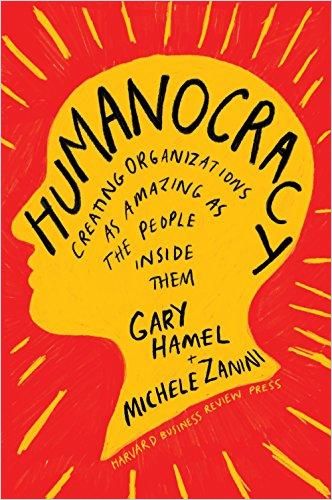Management Lab co-founders Gary Hamel and Michele Zanini outline a case for workplace democracy: transferring authority from managers to individual workers and small teams. Compelling case studies lend credence to their call for radical change.

Workplaces for Workers
Management thought leader Gary Hamel has long argued bureaucracy destroys profits and productivity. For decades he’s been rocking the corporate boat, insisting managers develop new work paradigms to enhance their competitive advantage. Here, he and co-author Michele Zanini, a former senior consultant at McKinsey, portray bureaucratic methods as holdovers from the Industrial Age: Leaders micromanage employees, suppress and steal their ideas and bury them in rules and administrativia.
The typical medium- or large-scale organization infantilizes employees, enforces dull conformity and discourages entrepreneurship.Gary Hamel and Michele Zanini
Exemplary organizations, Hamel and Zanini believe, implement principles and structures to contain bureaucracy. These cutting-edge organizations invest in employee development, and they listen to and leverage the creativity of every worker – hourly, blue-collar, contract and professional. As a result, these firms innovate, achieve growth and pay their workers well.
Hamel and Zanini advocate the eradication of most managerial positions. They point to an enormous international project in 1992 in which 3,000 scientists came together to unravel the deepest mysteries of the universe. Democratically – without a hierarchy or a leader – the scientists built a massive particle detector with more than 10 million parts. Leadership proved essential, yet no one could order anyone else to do anything.
Eliminate Most Management Positions
Hamel and Zanini don’t hold back in expressing their disdain for individuals they call bureaucrats – including managers, who, they contend, mostly generate busy work for their reports. They estimate cutting administration to about 10% of the workforce would save the economy trillions.
The authors point to firms that have flourished by eliminating middle management. At Morningstar, the most profitable tomato processor in the United States, no one has a boss or title. People work in teams and report to one another. Because people build their personal capital by enhancing their reputation, Morningstar employees share knowledge and help one another. Ideas and contributions matter. Every job enjoys respect and has meaning.
An increasingly complex world has outgrown organizational top-down command-and-control leadership.Gary Hamel and Michele Zanini
Hamel and Zanini argue the secret of top-performing organizations lies in fitting the workplace to the worker, by heeding age-old psychological truths about the human need for autonomy, learning, community and purpose. They reference Southwest Airlines, the most profitable US airline, where leaders invite and empower all workers to invent new ways to improve service and save money. All employees enjoy autonomy, receive training in business acumen, work in teams and serve on short-term assignments to learn about the company and its processes. Southwest designed its business and work environment to foster purpose, openness, autonomy and community, Hamel and Zanini say. Its employees’ commitment derives from a shared mission, accountability and – as the airline’s founder insists – love.
Prioritize People’s Potential
Hamel and Zanini discuss Nucor Steel, whose leaders credit its rapid success to the expertise and autonomy of its blue-collar workforce. The company invested extensively in developing workers’ business skills and other non-technical training. Nucor’s highly collaborative, team-oriented environment features minimal bureaucracy and high levels of trust and accountability.
Whatever your organization makes or sells, its real business is growing human beings.Gary Hamel and Michele Zanini
At Haier, a $38 billion manufacturer, every employee serves on a small team within one of the company’s 4,000 microenterprises. Each team has its own profit and loss (P&L) account, determines its own investments in technology, attracts people to its ideas and ventures, and manages customer relations. Despite its size, Hamel and Zanini observe, Haier remains nimble, light on bureaucracy and entrepreneurial by drawing on the creativity and innovation of its 84,000 employees and thousands of partners.
Promote ‘Humanocratic’ Principles
Hamel and Zanini call the principles that Nucor, Haier, Southwest and Morningstar exhibit “humanocratic.” According to the authors, each of these organizations leverages the following seven powers:
- Ownership: Leaders distribute power, link pay to performance, share profits and emphasize small teams, giving them P&L and purchasing authority.
- Markets: Humanocracies rely on the wisdom of the workforce. Employees pitch ideas, and peers vote on them. Internal services enjoy no monopoly.
- Meritocracy: These organizations reject hierarchies and politics, favoring domain expertise over job titles or salaries. They help people learn continuously, and they put the power of hiring and firing managers in the hands of the teams that report to them.
- Community: Humanocracies encourage peer social networks and self-organization, bringing people together with a shared purpose and common goals. They foster learning, trust, respect and accountability.
- Openness: Humanocracies practice transparency, explore untapped markets, challenge conventional wisdom, remain curious and welcome divergent thinking.
- Experimentation: They fund small experiments and make it safe for teams and workers to fail intelligently.
- Paradox: Humanocracies favor experimentation over investments in legacy cash cows, decentralization over centralization and openness over secrecy.
Apply Activist Tactics
If you lack authority to make radical change, Hamel and Zanini suggest starting with yourself and building from there. Don’t pretend to like superiors’ thinking; when you disagree with decisions or ideas, challenge them. Develop your people, put the business ahead of yourself and your team, and don’t blame others or take false credit. Hamel and Zanini implore managers to think like hackers, who target and tackle hard problems with curiosity and experimentation, and inspire creativity in others.
Don’t stop with yourself and your team, say the authors: Take on your organization. Look for mavericks who crave change, and together target the most egregious bureaucratic waste. Stage a hackathon to find solutions.
Most of us spend a lot more time thinking about practices than principles. That, as much as anything else, explains why we’re stuck.Gary Hamel and Michele Zanini
Press for changes in leadership approaches and philosophies. Demonstrate the benefits of organizing workers in decentralized teams that have autonomy and decision-making authority. Deliver value by seeking new opportunities, coaching and mentoring people, and renewing business models.
Proceed with Caution
Hamel and Zanini’s advice runs counter to conventional wisdom. They leave out experiments at Google, Zappos and other companies where the elimination of managers has come up short. No one would disagree with cutting bureaucracy, but before you implement Hamel and Zanini’s recommendations, consider your organization’s context and whether implementing a different role for managers – that of coach – might promote humanocracy just as well.
Gary Hamel also wrote Competing for the Future, Leading the Revolution, The Future of Management and What Matters Now. Michele Zanini contributes frequently to the Harvard Business Review, the Financial Times, the McKinsey Quarterly, Fast Company and Fortune. Hamel and Zanini recently launched a video series, “The New Human Movement,” featuring conversations with dozens of leading thinkers, CEOs and entrepreneurs who are innovating in management.







